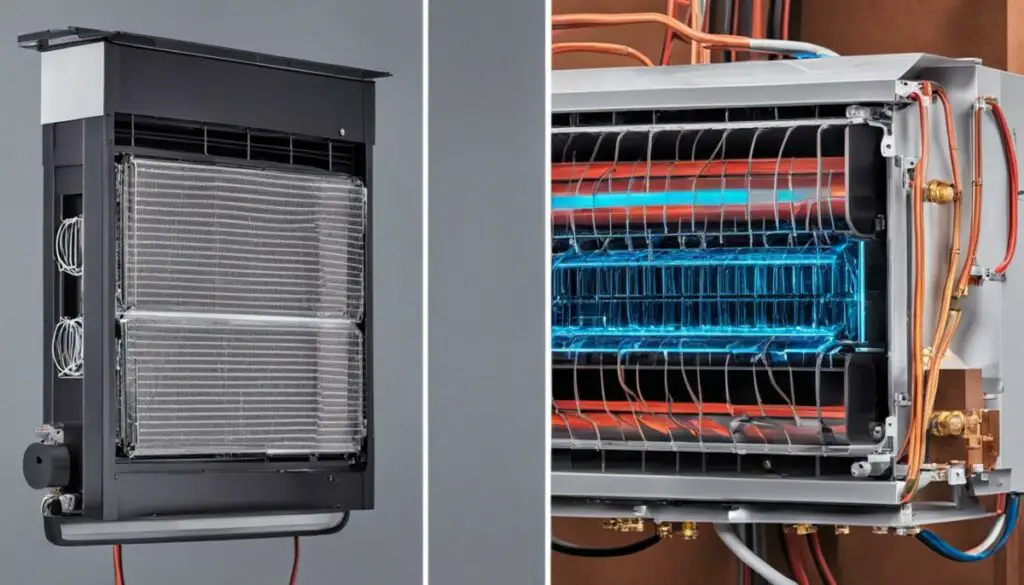Last Updated on 4 months by Francis
When it comes to energy-efficient heating solutions, two popular options that often come up for comparison are infrared heaters and heat pumps. Both these systems offer unique advantages and have their place in the market. In this article, we will dive into a detailed comparison of the efficiency of infrared heaters and heat pumps to help you make an informed decision for your heating needs.
Infrared heating works by emitting infrared radiation that directly heats objects, providing targeted heating. On the other hand, heat pumps extract heat from the ground or air to provide warmth. While both systems have their merits, understanding their efficiency and performance is crucial in choosing the right heating system for your home or business.
Contents
Key Takeaways:
- Infrared heaters and heat pumps offer distinct advantages and have different applications.
- Infrared heating is known for its targeted heating and energy efficiency.
- Heat pumps provide higher overall efficiency and can provide hot water in addition to heating.
- Consider factors such as running costs, installation requirements, and long-term investment when choosing between the two systems.
- Consulting with heating experts can help determine the most suitable option for your specific needs.
What is Infrared Heating?

Infrared heating is a form of heating that emits infrared radiation to directly heat objects, as opposed to traditional convection heating methods that heat the air. This innovative heating solution offers targeted and efficient warmth by heating the objects in its path.
There are two types of infrared heaters available: gas-fired IR heating and electric infrared heating. Gas-fired IR heaters utilize gas combustion to emit infrared radiation, while electric infrared heaters work by passing an electric charge through a material, causing it to emit infrared radiation.
Unlike traditional heating systems that warm the entire area, infrared heating is particularly effective in spaces where heating the entire area is not necessary. It can be used in a variety of settings, including industrial warehouses, outdoor patios, and even residential spaces.
Infrared heating offers numerous advantages, such as energy efficiency and targeted heating. By directly heating the objects, such as furniture and bodies, infrared heating reduces overall energy consumption and provides comfortable warmth.
To illustrate the concept of infrared heating, consider this quote from a heating expert:
“Infrared heating is like basking in the sun’s warmth. It delivers focused heat directly to the objects, making it efficient and cost-effective.”
Infrared heating technology is constantly evolving, with ongoing research and development to enhance its efficiency and effectiveness. As a result, it continues to gain popularity as a sustainable and efficient heating solution.
Benefits of Infrared Heating

Infrared heating offers several benefits that make it an attractive option for efficient and targeted heating. One of the key advantages of infrared heating is its energy efficiency. Unlike traditional heating systems, infrared heating only heats the objects that need heating, such as bodies, rather than wasting energy on heating the entire space. This targeted heating approach reduces energy consumption and minimizes heat loss.
Another advantage of infrared heating is the use of resistive heating technology. Resistive heating occurs when a material resists an electric current and emits radiation. Infrared heaters utilize this technology to generate and emit infrared radiation, which directly heats objects, surfaces, and people in the vicinity. This method of heating ensures that the heat is delivered precisely where it is needed, creating a comfortable and efficient heating solution.
Compared to other heating systems, infrared heating offers several key benefits:
- Energy efficiency: Infrared heating requires less energy overall due to targeted heating, resulting in lower energy consumption and reduced utility bills.
- Comfortable warmth: By directly heating objects and people, infrared heating provides a more comfortable and even distribution of warmth throughout the space.
- Quick heat-up time: Infrared heaters produce almost instant heat, allowing for quick and efficient heating when needed.
- Zoned heating: Infrared heating can be easily divided into zones, allowing for personalized temperature control and energy savings.
- No air circulation: Unlike conventional heating systems, infrared heating does not rely on forced air circulation, minimizing dust and allergen dispersal.
In summary, the benefits of infrared heating, including its energy efficiency, targeted heating capabilities, and resistive heating technology, make it a compelling choice for those seeking a cost-effective and comfortable heating solution.
| Benefits of Infrared Heating |
|---|
| Energy efficiency |
| Targeted heating |
| Resistive heating technology |
| Comfortable warmth |
| Quick heat-up time |
| Zoned heating |
| No air circulation |
Issues with Infrared Heating

While infrared heating offers several benefits, such as energy efficiency and targeted heating, there are some concerns that need to be addressed. These concerns can affect the overall comfort and effectiveness of the heating system.
Damp and Mold
One major concern with infrared heating is the potential for dampness and mold growth in buildings. As infrared heaters primarily heat objects rather than the air, it can lead to lower overall temperatures in the building. This reduction in heat demand can result in the accumulation of moisture in certain areas, which can create the ideal conditions for dampness and mold to thrive.
Heat Shadows
Another issue with infrared heating is the creation of heat shadows. Objects placed in front of the infrared heater can block the radiation, creating areas with inconsistent heating. This can lead to discomfort and uneven distribution of heat throughout the space.
Comfort Issues
Comfort can also be a concern with infrared heating. Since the heat is primarily directed towards objects, only the areas directly exposed to the infrared radiation will experience significant heating. This can result in temperature variations within a room, making it challenging to achieve uniform comfort levels.
Addressing these concerns is essential to ensure the efficient and effective operation of an infrared heating system. Proper insulation, careful placement of objects, and regular monitoring of moisture levels can help mitigate these issues and provide a more comfortable heating experience.
| Concerns | Solutions |
|---|---|
| Damp and Mold | Ensure proper insulation and ventilation. |
| Heat Shadows | Avoid placing objects that block the infrared radiation. |
| Comfort Issues | Use supplemental heating methods in areas where infrared heating may not reach. |
Why Choose Heat Pumps?
When it comes to selecting a heating solution for your home or building, heat pumps offer a range of advantages over infrared heating. While the initial installation cost of heat pumps can be higher, the long-term benefits they provide make them a worthwhile investment.
One of the key advantages of heat pumps is their efficiency. These systems can produce 3-4 units of heat for every unit of electricity consumed, making them highly efficient in converting energy into usable heat. This efficiency translates into substantial cost savings on electricity bills, especially when compared to traditional heating methods.
From a carbon perspective, heat pumps also shine. They have lower carbon emissions compared to other heating systems, contributing to a greener and more sustainable environment. By choosing a heat pump, you’re not only saving money but also reducing your carbon footprint.
In addition to their efficiency and environmental benefits, heat pumps can provide hot water, further adding to their value. This comprehensive heating solution eliminates the need for separate water heaters, saving both space and additional expenses.
Challenges with Heat Pumps

Despite their advantages, heat pumps present some challenges that need to be taken into consideration when considering them as a heating solution. These challenges include:
- Installation: The installation process for heat pumps can be more complex compared to other heating systems. It may involve intricate electrical work, plumbing, and extensive modifications to the existing infrastructure of the building.
- Planning Permission: In certain cases, installing a heat pump may require obtaining planning permission from local authorities. This step is necessary to ensure compliance with regulations and to address any potential environmental or aesthetic concerns.
- Efficiency in Cold Weather: Heat pumps may be less efficient in colder weather conditions. As the temperature drops, the heat pump may need to work harder and run continuously to maintain the desired indoor temperature. This increased demand can lead to decreased overall efficiency and potential energy consumption.
- Retrofitting: Retrofitting a heat pump into an existing heating system can be a complex and costly process. It often requires extensive modifications to the building’s infrastructure, including ductwork, electrical systems, and insulation. The retrofitting process can be disruptive and time-consuming, making it less practical for some buildings.
While these challenges exist, they can be mitigated with careful planning and professional installation. It is important to consult with qualified HVAC specialists who can assess the specific requirements of your building and provide expert advice on overcoming these challenges.
Despite the challenges, heat pumps remain a promising and increasingly popular heating solution due to their energy efficiency and environmental benefits.
Expert Quote:
“Installing a heat pump requires considering multiple factors such as the building’s layout, insulation, and heating needs. It’s crucial to work with experienced professionals who can navigate the challenges and ensure a successful installation.” – Jane Smith, HVAC Specialist
Efficiency Comparison

When it comes to efficiency, understanding the performance of different heating systems is crucial. In this section, we will compare the efficiency of heat pumps and infrared heating, specifically focusing on direct acting electric heaters.
Theory and Assumptions
Direct acting electric heaters, such as infrared heaters, are assumed to be 100% efficient. This means that all the electrical energy consumed is converted into heat without any loss. On the other hand, heat pumps are considered to be theoretically 250% efficient. This is because heat pumps extract heat from the outside air or ground and transfer it into the building, providing more heat output compared to the electrical energy input.
Dropping Temperatures and Consistency
However, the efficiency of heat pumps is affected by outside ambient air temperature. As the temperature drops, the efficiency of heat pumps decreases, making them less effective in colder climates. In contrast, infrared heating remains relatively consistent regardless of the external temperature.
“Independent tests have shown that infrared heating can be more efficient than heat pumps in certain temperature ranges.”
In these temperature ranges, the efficiency of infrared heating surpasses that of heat pumps, making it a compelling choice for efficient and cost-effective heating solutions.
Running Costs and Investment
When considering the running costs and overall investment of heat pumps versus infrared heating, it’s essential to take various factors into account. While heat pumps may have lower energy running costs, they often require annual servicing, which can add to the overall expenses. On the other hand, infrared heating has lower capital outlay costs, making it a more affordable option during installation. Additionally, infrared heating can prove to be more cost-effective over the lifetime of the system.
The specific costs and savings associated with both heat pumps and infrared heating will depend on several factors, including the size of the property, insulation levels, and electricity rates. It’s crucial to evaluate these factors carefully when making a decision about the most suitable heating solution.
Comparing Running Costs
Heat pumps are generally known for their lower energy running costs. These systems efficiently extract heat from the air or ground, relying on electricity for operation. The Coefficient of Performance (COP) of heat pumps can range from 3 to 4, meaning that for every unit of electricity consumed, they produce three to four units of heat. This high efficiency helps reduce energy consumption and lowers running costs over time.
On the other hand, infrared heating operates by emitting infrared radiation directly to objects. While individual running costs may vary depending on the specific system used, infrared heating generally consumes less energy compared to traditional heating systems. By heating targeted areas or objects, it avoids unnecessary energy waste in heating unoccupied spaces.
Considering Lifetime Costs
When assessing the lifetime costs of heat pumps and infrared heating, it’s essential to consider not only the upfront capital outlay but also the potential maintenance and repair expenses. Heat pumps often require regular servicing to maintain optimal performance, which can add to the overall lifetime costs. On the other hand, infrared heating systems typically have lower capital outlay costs, making them a cost-effective choice in terms of initial investment.
Additionally, the maintenance requirements for infrared heating systems are usually minimal. They don’t have complex mechanical components, reducing the need for regular maintenance and potential repair costs. This factor can contribute to the long-term cost-effectiveness of infrared heating systems.
Choosing the Best Option
The decision between heat pumps and infrared heating should be based on a careful evaluation of the running costs, upfront investment, and anticipated lifetime costs. It’s essential to consider factors such as energy efficiency, specific heating needs, and long-term savings. The size of the property, insulation levels, and electricity rates should also be taken into account when comparing the financial implications of both options.
Ultimately, the optimal choice will depend on individual circumstances and priorities. Consulting with heating experts and conducting a thorough cost analysis will help ensure the selection of the most suitable heating solution for your needs.
Conclusion
In conclusion, when comparing the efficiency of infrared heaters and heat pumps, several factors must be considered. The efficiency comparison depends on factors such as building insulation, temperature ranges, and specific heating requirements.
While infrared heating offers the advantage of targeted heating and potentially lower initial costs, heat pumps provide a higher overall efficiency and the added benefit of providing hot water. The decision between the two heating solutions should take into account not only the efficiency comparison but also the running costs, installation requirements, and long-term investment.
Assessing individual needs and consulting with heating experts is highly recommended to determine the most suitable option for each situation. By carefully considering factors such as running costs and long-term investment, homeowners and property owners can make an informed choice that meets their heating needs while also ensuring energy efficiency and cost-effectiveness in the long run.
FAQ
Are infrared heaters more efficient than heat pumps?
The efficiency of infrared heaters and heat pumps depends on various factors such as building insulation, temperature ranges, and specific heating requirements. While infrared heaters offer targeted heating and potentially lower initial costs, heat pumps provide higher overall efficiency and the ability to provide hot water. The decision between the two heating solutions should take into consideration factors such as running costs, installation requirements, and long-term investment.
What is the difference between infrared heating and convection heating?
Infrared heating emits infrared radiation, which directly heats objects rather than heating the air like traditional convection heating. This targeted heating approach can be more energy efficient, as it only heats the objects that require heating, such as bodies. In contrast, convection heating relies on heating the air in a space to warm the surrounding objects.
What are the benefits of infrared heating?
Infrared heating offers several benefits, including energy efficiency. It requires less energy overall compared to traditional heating systems because it only heats the objects that need heating, such as bodies. This targeted heating approach can create a comfortable and efficient heating solution. Additionally, infrared heating falls under the category of resistive heating, where a substance resists an electric current and emits radiation.
What are the concerns with infrared heating?
While infrared heating has its benefits, there are some concerns associated with it. By reducing the overall heat demand of a building and targeting specific items, the building may be colder overall, leading to issues such as damp and mold. Additionally, the placement of objects in the space can create heat shadows, causing inconsistent heating. Comfort issues may also arise, as only the areas directly exposed to the infrared radiation will experience significant heating.
What are the advantages of heat pumps?
Heat pumps offer several advantages over infrared heating. While they may be more expensive to install initially, heat pumps provide a higher efficiency, with an output of 3-4 units of heat for every unit of electricity. This can result in significant cost savings and lower carbon emissions. Heat pumps can also provide hot water, making them a more comprehensive heating solution. From a long-term perspective, heat pumps are often considered a cheaper and more deliverable option.
What challenges come with using heat pumps?
Heat pumps do come with some challenges. Installation can be more complex and may require planning permission in certain cases. Additionally, heat pumps may be less efficient in colder weather, requiring them to run continuously and potentially decreasing their overall efficiency. Retrofitting heat pumps into existing heating systems can be expensive and disruptive, making them less practical for some buildings.
How do the efficiency of infrared heaters and heat pumps compare?
In terms of efficiency, infrared heaters are classified as “Direct Acting Electric Heaters” and are assumed to be 100% efficient. Heat pumps, on the other hand, are assumed to be 250% efficient in theory. However, the efficiency of heat pumps decreases as the outside ambient air temperature drops, while infrared heating remains relatively consistent. Independent tests have shown that infrared heating can be more efficient than heat pumps in certain temperature ranges.
What are the running costs and investments associated with infrared heaters and heat pumps?
When comparing the running costs and overall investment of heat pumps and infrared heating, several factors come into play. While heat pumps may have lower energy running costs, they often require annual servicing, which adds to the overall expenses. Infrared heating, on the other hand, has lower capital outlay costs and can be more cost-effective over the lifetime of the system. The specific costs and savings will depend on factors such as the size of the property, insulation levels, and electricity rates.









